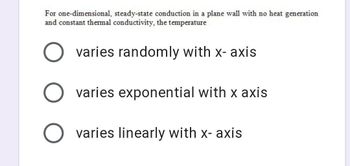
Introduction to Chemical Engineering Thermodynamics
8th Edition
ISBN: 9781259696527
Author: J.M. Smith Termodinamica en ingenieria quimica, Hendrick C Van Ness, Michael Abbott, Mark Swihart
Publisher: McGraw-Hill Education
expand_more
expand_more
format_list_bulleted
Question

Transcribed Image Text:For one-dimensional, steady-state conduction in a plane wall with no heat generation
and constant thermal conductivity, the temperature
varies randomly with x-axis
O varies exponential with x axis
O varies linearly with x-axis
Expert Solution
This question has been solved!
Explore an expertly crafted, step-by-step solution for a thorough understanding of key concepts.
Step by stepSolved in 2 steps with 1 images

Knowledge Booster
Similar questions
- A metallic sphere of radius R is heated in an oven to a temperature of 600 ° F throughout, and then removed from the oven and allowed to cool in ambient air to T∞ = 75 ° F, by convection and radiation (see attached figure). The thermal conductivity of the ball material is known to vary linearly with temperature. Assuming that the ball is uniformly cooled starting from the entire outer surface, obtain the differential equation that describes the change in temperature in the sphere during cooling. Note: In the image, the translation would be: metallic spherearrow_forwardSolution the question in 15 mintarrow_forwardTwo identical 7.5-cm cubes of copper at 425 and 90°C are brought into contact. Assuming that the blocks exchange heat only with each other and that there is no resistance to heat flow as a result of the contact of the blocks, plot the temperature of each block as a function of time, using the lumped-capacity method of analysis. That is, assume the resistance to heat transfer is the conduction resistance of the two blocks. Assume that all surfaces are insulated except those in contact.arrow_forward
- You can in handwritten also. A circular (annular) fin of radius r2 is attached to a pipe of radius r1. The fin is exposed to an ambient fluid at temperature T∞ having heat transfer coefficient h and the fin base is maintained at temperature Tb. The fin thickness (t) is small compared to the fin length and the heat loss from the fin tip can be considered negligible compared with that from the top and bottom surfaces of the fin. Derive the differential equation and the boundary conditions for this fin by writing an energy balance around a differential volume element. Write your assumptions in detail. Do not solve the differential equation.arrow_forwardThe exposed surface (x = 0) of a planar wall of thermal conductivity k is subject to microwave radiation that causes the volumetric heating to vary as: q ̇ (x) = q ̇o (1-x / L) Where qo (W / m ^ 3) is a constant. The boundary of x = L is well insulated, while the exposed surface is kept at a constant temperature T0. Determine the temperature distribution T (x) in terms of x, L, k, q ̇o, and T0. in the attached image it is in Spanisharrow_forwardConsider a 2-ft * 2-ft thin square plate in a room at 75°F. One side of the plate is maintained at a temperature of 130°F, while the other side is insulated. Determine the rate of heat transfer from the plate by natural convection if the plate is (a) vertical, (b) horizontal with hot surface facing up, and (c) horizontal with hot surface facing down.arrow_forward
- A steel sphere of diameter d and thermal conductivity k is being cooled in a flowing stream of air of bulk temperature T. The temperature distribution in the ball at a particular instant can be approximated as T- a + br + crª, where a, b and c are functions of time, and I is in K. What is the surface heat transfer coefficient? What is the unit of b?arrow_forwardConsider a cylindrical cavity of diameter D =100 mm and depth L = 10 mm whose sidewall and bottom are diffuse and gray with an emissivity of 0.6 and are at a uniform temperature of 1500 K. The top of the cavity is open and exposed to surroundings that are large and at 300 K. (a) Calculate the net radiation heat transfer rate from the cavity, in W, treating the bottom and sidewall of the cavity as one surface. (b) Calculate the net radiation heat transfer rate from the cavity, in W, treating the bottom and sidewall of the cavity as two separate surfaces.arrow_forward
arrow_back_ios
arrow_forward_ios
Recommended textbooks for you
 Introduction to Chemical Engineering Thermodynami...Chemical EngineeringISBN:9781259696527Author:J.M. Smith Termodinamica en ingenieria quimica, Hendrick C Van Ness, Michael Abbott, Mark SwihartPublisher:McGraw-Hill Education
Introduction to Chemical Engineering Thermodynami...Chemical EngineeringISBN:9781259696527Author:J.M. Smith Termodinamica en ingenieria quimica, Hendrick C Van Ness, Michael Abbott, Mark SwihartPublisher:McGraw-Hill Education Elementary Principles of Chemical Processes, Bind...Chemical EngineeringISBN:9781118431221Author:Richard M. Felder, Ronald W. Rousseau, Lisa G. BullardPublisher:WILEY
Elementary Principles of Chemical Processes, Bind...Chemical EngineeringISBN:9781118431221Author:Richard M. Felder, Ronald W. Rousseau, Lisa G. BullardPublisher:WILEY Elements of Chemical Reaction Engineering (5th Ed...Chemical EngineeringISBN:9780133887518Author:H. Scott FoglerPublisher:Prentice Hall
Elements of Chemical Reaction Engineering (5th Ed...Chemical EngineeringISBN:9780133887518Author:H. Scott FoglerPublisher:Prentice Hall
 Industrial Plastics: Theory and ApplicationsChemical EngineeringISBN:9781285061238Author:Lokensgard, ErikPublisher:Delmar Cengage Learning
Industrial Plastics: Theory and ApplicationsChemical EngineeringISBN:9781285061238Author:Lokensgard, ErikPublisher:Delmar Cengage Learning Unit Operations of Chemical EngineeringChemical EngineeringISBN:9780072848236Author:Warren McCabe, Julian C. Smith, Peter HarriottPublisher:McGraw-Hill Companies, The
Unit Operations of Chemical EngineeringChemical EngineeringISBN:9780072848236Author:Warren McCabe, Julian C. Smith, Peter HarriottPublisher:McGraw-Hill Companies, The

Introduction to Chemical Engineering Thermodynami...
Chemical Engineering
ISBN:9781259696527
Author:J.M. Smith Termodinamica en ingenieria quimica, Hendrick C Van Ness, Michael Abbott, Mark Swihart
Publisher:McGraw-Hill Education

Elementary Principles of Chemical Processes, Bind...
Chemical Engineering
ISBN:9781118431221
Author:Richard M. Felder, Ronald W. Rousseau, Lisa G. Bullard
Publisher:WILEY

Elements of Chemical Reaction Engineering (5th Ed...
Chemical Engineering
ISBN:9780133887518
Author:H. Scott Fogler
Publisher:Prentice Hall


Industrial Plastics: Theory and Applications
Chemical Engineering
ISBN:9781285061238
Author:Lokensgard, Erik
Publisher:Delmar Cengage Learning

Unit Operations of Chemical Engineering
Chemical Engineering
ISBN:9780072848236
Author:Warren McCabe, Julian C. Smith, Peter Harriott
Publisher:McGraw-Hill Companies, The